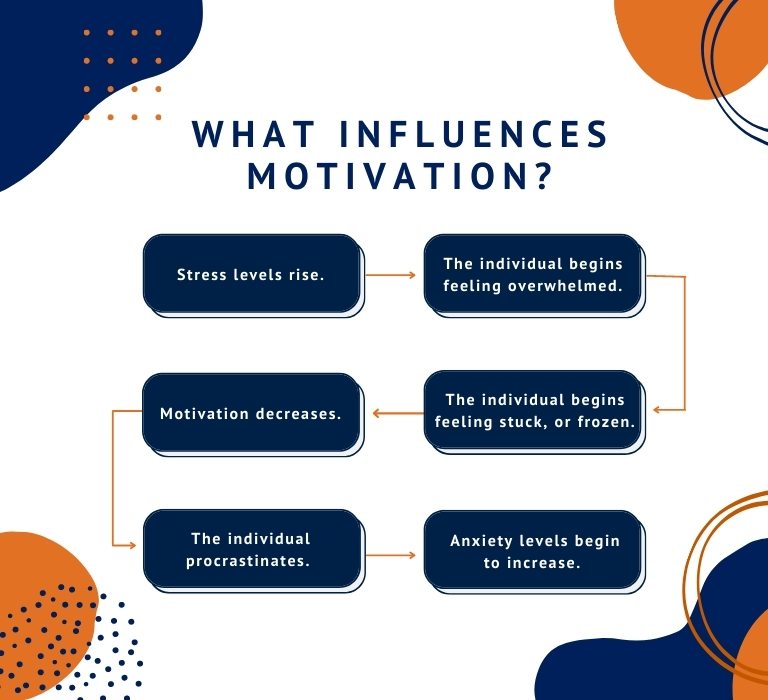Tips for Finding Motivation

Finding motivation isn’t always an easy task. Whether an individual’s goals are as broad as improving financial wellness or as specific as going to the gym three times a week, it’s natural for them to feel somewhat overwhelmed and unmotivated, especially at the start. For many people, low motivation has been exacerbated by the COVID-19 pandemic, which erased the division between home and work as remote life took off.
“We were used to having a story of our day: Waking up with morning rituals, driving to work, going to the office, and coming home for dinner,” said Risa Williams, a licensed marriage and family therapist and adjunct professor at the Pepperdine Graduate School of Education and Psychology. “The pandemic interrupted this story for a lot of people, so being at home all the time became a rough adjustment and changed how they spent their time. The lack of structure made them feel uncomfortable, which turned into longer feelings rooted in a lack of motivation.”
But finding motivation again is possible. Williams, who recently published the book The Ultimate Time Management Toolkit, shared her thoughts on how to build momentum to overcome mental obstacles, even when it feels too stressful.
What Is Motivation?
The American Psychological Association (APA) defines motivation as a sense of direction or purpose in behavior that drives people to achieve their goals. Feeling unmotivated can affect many different areas of life, especially careers.
According to a 2021 APA article on finding motivation in the workplace, there are three main psychological needs that support goal-directed behaviors:
Autonomy
feeling in control of your behavior
Competence
feeling you’re capable of producing the outcomes you want
Relatedness
feeling the need to be connected to other people
When these psychological needs are satisfied, motivation increases.
This can be reflected in post-COVID work environments. When the pandemic hit, many workers were suddenly confined to their homes, forced to complete tasks that made them feel “bumbling and helpless” and isolated from colleagues due to social distancing.
A 2020 Pew Research Center poll on how the coronavirus outbreak changed the way people work found that, of employed adults who had been predominantly working from home since the beginning of the pandemic:
1/3
of all respondents felt unmotivated to do their work.
>50%
of 18-to 29-year-old respondents felt unmotivated to do their work.
What Influences Motivation?
Stress influences our feeling of motivation to complete tasks, Williams said. It can affect the body, particularly the prefrontal cortex, which processes information. When stress gets too high, the functioning of the prefrontal cortex can shut down, which reduces the ability to think logically and make choices on how to proceed. Time may feel like it’s closing in on the individual.
Williams describes the relationship between stress and motivation below:

How to Find Motivation
Finding motivation to be productive and applying that consistently can be challenging when people feel anxious or stressed, as well as apathetic or unenergetic. But Williams offers three overarching steps to help a person who feels stuck:
1.
Engage in self assessments.
2.
Improve self-talk.
3.
Plan time strategically.
“It’s important for people to learn how to bring their stress down a little and get into a calmer mindset. When we relax ourselves, it’s easier to plan the next step forward,” Williams said.
Williams recommends learning how to assess and evaluate oneself more regularly, particularly one’s needs, moods, and energy levels. Questions that individuals may ask themselves include:
- Are there signs that I am mentally exhausted and tired?
- What are the signs that my body is giving me when I’m burnt out?
- On a scale of 1-10, how overwhelmed am I feeling right now?
“It can also be helpful to journal about why you’re feeling stuck, and then try to come up with some actionable strategies you can take,” she added.
After acknowledging how they feel, an individual should also consider how they talk to themselves. Williams said that how we talk to ourselves on a regular basis is critical to our motivational levels.
“If you’re engaging in a lot of negative self-talk, this will decrease your motivation to do something,” she explained. “But if you cheer yourself on and give yourself more credit for the small steps you take to move forward, that helps you better navigate your goals.”
The more people can start to feel like a task is achievable—in part because they’re telling themselves that it is—the more motivation kicks in and helps build confidence to complete the task.
Suggestions for Improving Self-Talk
| Don’t say this | Instead, say this |
|---|---|
“I can’t begin to start this task. I don’t understand it.” | “I’m getting better at adapting to new things.” |
“This task is the worst. I’m never going to finish it.” | “I’m going do what I can handle now, and I can always do more later.” |
“This task feels impossible. I’m bad at this.” | “I can figure this out. I’m going to take it one step at a time.” |
Tasks can also feel less overwhelming when individuals plan their time strategically and include down time for mental resets. To improve time management, individuals can:
Take breaks often.
A 15-minute time buffer in between tasks can make them feel less stressful to re-engage with and remove pressure to complete everything all at once.
Divvy up tasks.
Make chunks of time feel distinct by switching between different types of tasks (i.e., cleaning the home, then sitting down to work, followed by making food).
Plan small rewards.
A small reward can incentivize finishing a task. Rewarding oneself at the end of the day can also help a person shift to relaxation mode more deliberately.
“Switching things up for your brain and creating a clear division will help your motivation because you’ll see there’s an end to the stress,” Williams said. “You can have something to look forward to.”
Simple Activities to Improve Motivation
There are also a number of simple daily activities that are designed to stimulate people’s minds when they are feeling stuck. Here are some activities (pulled from chapters in The Ultimate Time Management Toolkit) that may help boost motivation and productivity include:
Brain Warm-Up
The problem: You’re struggling to re-engage with a significant task that you have little motivation to move forward with.
The solution: Find a different task to help you mentally prepare for the bigger task. It should be short, like a crossword puzzle or word search that will “warm your brain up” for 15 to 30 minutes.
Example: If it’s an organizational project, delete some emails. If it’s a physical task, rearrange your pantry. If it’s a creative task, do a little writing exercise.
Mental Nudge
The problem: You might assign yourself a task and put it on your calendar but still not take initiative to accomplish it even when you see it.
The solution: Ask yourself what is the easiest and tiniest thing you can do to nudge yourself forward to complete the task.
Example: If you want to take more walks, set out your shoes by the door so it reminds you to get moving.
Weekly Post-It
The problem: You might have made to-do lists that are way too long and overwhelming, which makes you not want to look at them.
The solution: Pick three to five things that you want to focus on for the week and write them down on a Post-It note.
Example: Put the Post-It where you will visually see it every day, like your mirror. Have different notes for multiple categories, such as self-care or work.
But individuals should also remember to give themselves grace in situations where they feel stuck. Small steps that may seem insignificant in the moment can be important in the long run.
“Motivation often finds us after we’ve taken a little action forward,” Williams said.
Citation for this content: OnlinePsychology@Pepperdine, the Online Master of Psychology program from Pepperdine University.

